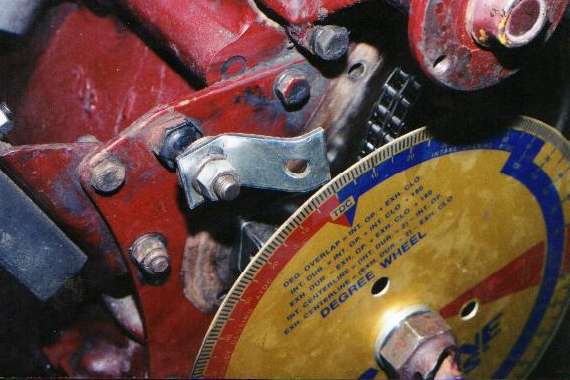The MGA With An Attitude
Finding TOP DEAD CENTER (TDC) Spot-On Accurate - CS-111C
Now that we understand the importance of measuring piston height a little way away from TDC, I will get on with the most accurate method of finding TDC, for when you must be spot on for indexing a special camshaft. For this you need a degree wheel and a piston stop (or a dial indicator if the cylinder head is off).

- Start by removing the crankshaft pulley, and attach a degree wheel in its place. This might not be necessary if you could figure out how to attach the degree wheel to the face of the pulley (not easy with the MG engine).
- Attach a fixed pointer near the edge of the degree wheel.
- Turn engine close to TDC (thumb on the spark plug port and eyeball the piston is close enough)
- Set degree wheel with TDC mark next to the pointer.
- Turn the crankshaft back about 20 degrees Before TDC.
- Install the piston stop in the spark plug port, and screw it down until it just touches the piston.
- Turn crankshaft to bring piston firmly (but gently) against the piston stop, then read and record the angle BTDC on the degree wheel.
- Turn crankshaft backward until the piston once again comes up against the piston stop (about 320 degrees back to get from 20 BTDC to 20 ATDC).
- Read and record the angle After TDC (expected to be different than the prior angle BTDC).
- Subtract the smaller angle from larger angle, and divide by 2. Reset the degree wheel by this amount, hopefully making the LH and RH stop (BTDC and ATDC) angles equal.
- Record the new ATDC stop angle.
- Turn the engine forward (about 320 degrees) until the piston comes up against the piston stop again.
- Compare the new BTDC stop angle to the new ATDC top angle. The intention is that the two stop angles (BTDC and ATDC) should then be identical. Is so, you are finished.
- If the angles are not the same, then split the difference and re-adjust the degree wheel accordingly.
- When you get the BTDC and ATDC stop angles to match, the TDC mark on the degree wheel will be exactly aligned with the real TDC of the engine.
- Turn the crankshaft to move the piston slightly away from the piston stop, and remove the piston stop.
- Turn the crankshaft to align the TDC mark on the degree wheel to the pointer, and it will be exactly spot on TDC.
|
If the cylinder head is off when you do this, then use a dial indicator to indicate height of the piston at about 20 degrees from TDC, about 1/8 inch (3 mm) down from top of stroke. Each time you turn the crankshaft left or right, bring the piston up to exactly the same height on the dial indicator. This has the same effect as using the piston stop. If the dial indicator has enough over-travel you can turn the engine over top past TDC, about 40 degrees to get from 20 BTDC to 20 ATDC (or vice versa) without needing to turn 320 degrees in the opposite direction.
The dial indicator will also be used for checking valve lift, valve over-travel (before impacting something), and for setting up cam timing any time the cam timing is going to be non-standard. This is covered in other tech articles. You can download complete instructions for use of the Tune-A-Cam tool kit from Crane Cams web site.
|
